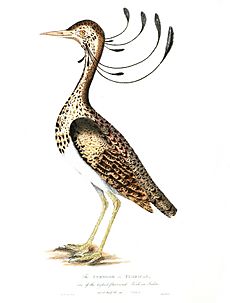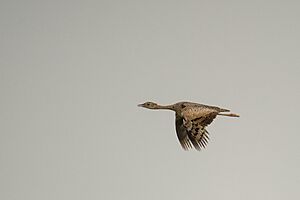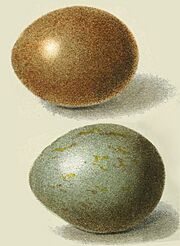Lesser florican facts for kids
Quick facts for kids Lesser florican |
|
|---|---|
 |
|
| Male | |
| Conservation status | |
| Scientific classification | |
| Genus: |
Sypheotides
|
| Species: |
indicus
|
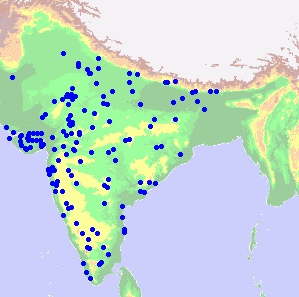 |
|
| Spot distribution map (includes historic records) | |
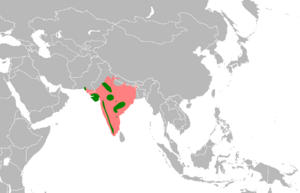 |
|
| Overall distribution (reddish) and breeding areas (green) | |
| Synonyms | |
|
Sypheotis aurita |
|
The lesser florican (Sypheotides indicus) is a special bird. It is also known as the likh or kharmore. This bird is the smallest in the bustard family. It is the only member of its group, called Sypheotides.
You can find the lesser florican only in the Indian Subcontinent. It lives in tall grasslands. This bird is famous for the amazing jumping displays its males perform. They do this during the monsoon season to attract mates.
Male lesser floricans have striking black and white feathers when breeding. They also have unique long feathers on their heads. These feathers stick out behind their necks. These bustards are mostly found in northwestern and central India in summer. In winter, they spread out more widely across India.
Sadly, the lesser florican is highly endangered. It has even disappeared from some areas, like Pakistan. Both hunting and losing their natural homes threaten these birds. The only similar bird is the Bengal florican. However, the Bengal florican is bigger. It also does not have a white throat, collar, or those long head feathers.
Contents
Understanding the Lesser Florican's Name
In 1782, an English artist named John Frederick Miller drew a female lesser florican. He gave it the scientific name Otis indica. Today, this bird is the only species in the group Sypheotides. This group was named in 1839 by a French scientist, René Lesson. The lesser florican is a unique species with no different types (subspecies).
The word "florican" is used for two smaller types of bustards. People think this word might come from Dutch. The lesser florican's group, Sypheotides, once included the Bengal florican. Both are small birds.
The lesser florican has long legs. Its male changes its feathers with the seasons. This is why it has its own special group name. These two bird groups are actually very closely related.
People used to think male and female floricans were different species. This led to different names like aurita and indica. The bird has been placed in other groups over time. Its local names often link it to peacocks. This is because of its body shape and how it holds its tail feathers. Some popular names mean "grass peacock." In northwestern India, it is called Likh.
What Does a Lesser Florican Look Like?
When a male lesser florican is ready to breed, it looks very striking. Its head, neck, and lower body are black. But its throat is bright white. From behind each ear, about three long, ribbon-like feathers grow. These feathers are about 4 inches long. They curve upwards and end in a flat, spoon-like tip.
The male's back and shoulder feathers have white V-shaped patterns. Its wing feathers are white. After the breeding season, the male's wings usually have some white.
The female lesser florican is a bit bigger than the male. Females and males not in breeding season look different. They are buff-colored with black stripes. They have darker marks on their heads and necks. Their backs have mottled black patterns. The neck and upper chest are buff, with fewer stripes towards the belly.
The outer wing feathers of males are thin and notched. The bird's legs are pale yellow, and its eyes are yellow. Young lesser floricans have a clear U-shaped mark on their neck near the throat.
Where Do Lesser Floricans Live?
The lesser florican used to live across much of the Indian Subcontinent. However, it was not found in Sri Lanka. Today, it mostly breeds in central and western India. There are old records of it living along the coast of Balochistan in Pakistan. A report from Burma has been questioned.
These birds are known to move around based on rainfall. They can appear in large numbers in some seasons. Scientists have tagged about 500 males in Gujarat. Most of them were found within 50 kilometers of where they were tagged.
Lesser floricans prefer to live in grasslands. But sometimes, they can be found in fields of crops like cotton or lentils. Today, their main breeding areas are in Gujarat, Madhya Pradesh, parts of southern Nepal, and Andhra Pradesh. Protecting these grasslands and mixing them with carefully managed croplands helps the floricans.
Lesser Florican Behavior and Lifestyle
These bustards are usually found alone or in pairs. They hide in thick grasslands or sometimes in crop fields. In the past, many males were hunted during breeding season. This was because their courtship displays made them easy to spot.
Lesser floricans fly faster than other bustards. When they fly, they look a bit like ducks.
What Do Lesser Floricans Eat?
Lesser floricans eat many different small animals and insects. Their diet includes worms, centipedes, lizards, frogs, and insects. They enjoy eating locusts, flying ants, and hairy caterpillars. They also eat plant parts like shoots, seeds, herbs, and berries.
Floricans usually feed in the early morning or evening. However, newly arrived birds might feed throughout the day.
Reproduction and Life Cycle
The breeding season for lesser floricans changes. It depends on when the Southwest Monsoon begins. In northern India, it's from September to October. In parts of southern India, it's from April to May.
During breeding season, male floricans perform an amazing show. They suddenly leap high from the grass. They make a special croaking or knocking sound. They flutter their wings and then fall back down with their wings slightly open. At the highest point of their jump, their neck arches backward. Their legs are folded as if they are sitting.
These jumps happen every three minutes or more. The males display mostly in the early mornings and late evenings. But they might display all day if the weather is cloudy.
Each male has its own territory, about 1-2 hectares in size. They use special display spots. In the past, hunting birds at these spots caused their numbers to drop sharply. These display spots are usually flat areas with low plants. They offer good visibility. Well-used spots often show signs of being trampled.
Female floricans have a way to protect their nest. They spread their wings, tail, and neck feathers. Females are said to make a whistling sound that attracts males. Males can be aggressive towards other males nearby.
The nest is a shallow dip on the ground. Females lay 3-4 eggs, each about 1.88 x 1.6 inches. The nest is usually hidden in thick grass. Only the female bird incubates the eggs and raises the chicks. The eggs hatch after about 21 days.



